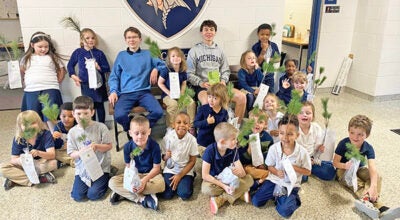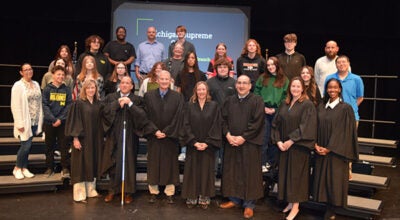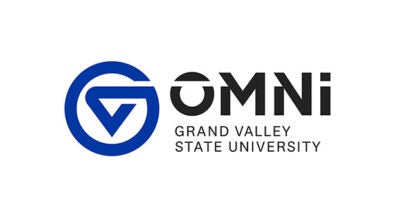STEM picking up steam
Published 8:00 am Tuesday, March 10, 2015
Southwestern Michigan College STEM is picking up STEAM.
Physics Professor Andrew Dohm exhibited creativity in problem-solving when he asked Professor Emeritus David Baker to expose Science, Technology, Engineering and Mathematics students to art.
Baker appeared in the Foster W. Daugherty Building to address 36 of Dohm’s and Chemistry Professor Dr. Douglas Schauer’s students.
“I see now that one of the things I never fully understood as a STEM student is the role of creativity,” Dohm said. “I labeled myself as not creative. I never took an art class in high school because I was afraid of it. At Michigan Tech I shied away from classes with ‘design’ in their title because I felt that connected to creative. Now I realize there are different types of creativity. You have to be a creative problem-solver. Just going through an engineering curriculum means you’re able to pull together information from different disciplines and apply it to solving a problem. I did it in industry and now in education.”
Baker compiled a packet of resources, drawing on researcher Alex Osborn, author of Applied Imagination.
Osborn wrote that everyone has some degree of imagination, but doubted it could be increased. He felt people were capable of better using what they possess, which led to brainstorming.
A group tackling problems together can identify more quality solutions than the same people working individually.
“We beat pre-calculus, calculus, chemistry and physics students over the head with problem-solving,” Dohm realized, “but miss the creative aspect. Employers want people who can innovate. We don’t want to just give math/science skills, we want to equip students with tools they can use now and in the future. We want to prepare them to participate in this world in which we live.
“To get STEM jobs, you’ve got to assess a problem and devise creative ways of attacking it. Growth is going to be in non-routine, high-skill jobs where you look at things differently for improvement.”
Dohm, awarded SMC’s inaugural Fulltime Faculty of the Year award last April, said one common mistake people make is “short-circuiting the process. They try to create and analyze at the same time, shutting the process down. (Baker) said you need to generate ideas, let them sit 48 hours, then evaluate them. He said your right brain creates ideas like red helium balloons. Your left brain acts like a shotgun and downs them with, ‘That will never work.’ A lot of people are not as creative as they could be because of that conflict.”
“He had us do a really cool brain exercise,” Dohm said. “We recited the alphabet as fast as we could. With our eyes still closed, they acted like a camera panning around our bedroom. He asked if reciting the alphabet was just verbal or could we ‘see’ some letters, which meant both halves of the brain were working. Same with the few people who had ‘commentary’ with the pictures.”
Baker also brought props — a ladder, a marble and a rock — to figure out a creative way to combine them.
To illustrate idea generation, Baker thumbed through his own sketchbook, seguing suddenly from a rough blueprint to a completed painting.
“It was so cool to see evidence of how he did that all the way,” Dohm said. “Art doesn’t come out of nowhere, but through this process. Everybody was at the edge of their seats. Then he said, ‘Now it’s your turn,’ and we brainstormed how to make a better baseball bat.
“They fired a zillion ideas at us as we wrote them on the board,” Dohm said. “Put Bluetooth in. Or Wi-Fi. Cameras. Fins. Spikes. Then he gave us restraints and wiped off all but six. When ideas were flowing, he used the analogy of microwave popcorn. A tentative pop. More pops. Then the flurry” when kernels careen into a fusillade.
Baker sketched two scenarios: Apollo 13, America’s third moon-landing mission in April 1970 when an oxygen tank exploded, crippling the module 205,000 miles from Earth.
He closed with something more down-to-earth. Zollar Café at the Student Activity Center ran out of his Uncommon Grounds coffee produced by an independent Saugatuck roaster due to a truck slide-off in an ice storm.
Baker wants delivery by them devising something using spare parts from a friend’s garage on Dogwood Circle.
“Know that Rotary Park is on the highest hill in town, topped by a 150-foot water tower. The park connects to the college running trails. Black, thank you, no sugar,” Baker commands.
One idea involved using coffee filters to make “parachutes” launched off the water tower.
Dean of Arts and Sciences Dr. Scott Topping and Science/Math Department Chairman Dr. Keith Howell evaluated their solutions for viability, with the winning team awarded Birdfeeder gift certificates.
“We’re going to continue down this path, not only with Dave Baker,” Dohm said. “(Director of Bands Dr. Jon) Korzun approached us about crossing over. I could provide physics explanations to what they do in music theory, like standing waves on a string when you adjust frequency. Dr. Howell has brought in (Visual and Performing Arts Chairman) Marc Dombrosky to Math 128 (Contemporary Math).”






